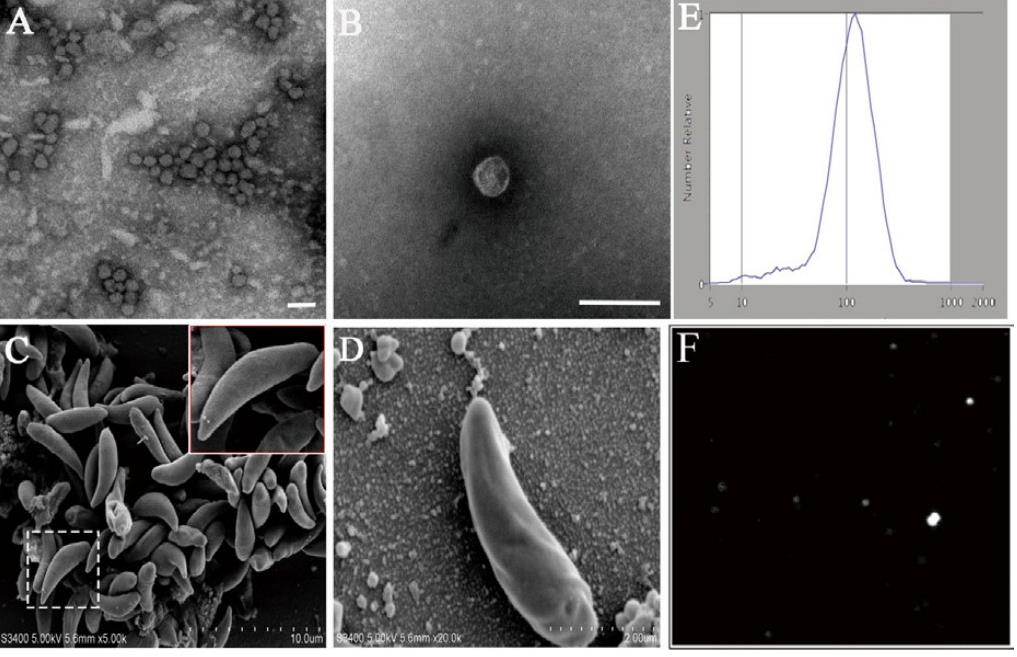|
Research item
|
Method
|
Conclusion
|
|
Identification of Neospora caninum capable of secreting exosomes.
|
Scanning electron microscopic observation of parasitic tachyzoites. Ultracentrifugation was used to isolate Neospora-derived exosomes from Neospora caninum growth media and then characterized.
|
The presence of Neospora-derived exosomes was observed on the surface of Neospora caninum tachyzoites with multivesicular body-like structures observed in their interior. There was a double membrane structure of Neospora-derived exosome was observed.
|
|
Protein cargo analysis of Neospora-derived exosomes.
|
Proteomic analysis and protein blotting analysis.
|
Neospora-derived exosomes contained cargoes that overlapped with other protozoan proteins that involved the MAPK signaling pathway and the toll signaling pathway. And 14-3-3, heat shock proteins and multiple Neospora-associated antigens, including the surface protein P36, the MIC family, and the SAG family were highly enriched in Neospora-derived exosomes.
|
|
Demonstration of Neospora-derived exosomes delivering their cargo to host cells.
|
Observation of the Neospora-derived exosomes' cargoes traced by fluorescent antibodies in host cells was performed by confocal microscopy.
|
An increased fluorescent signal was detected in mouse bone marrow-derived macrophages in a time-dependent manner, suggesting the transport of Neospora-derived exosome contents.
|
|
Analysis of Neospora-derived exosomes inducing host immunity and its mechanisms.
|
Cytokine profiling and protein blotting analysis of Neospora-derived exosome-treated target cells.
|
Neospora-derived exosomes promoted inflammatory infiltration of host immune cells by activating TLR2 and phosphorylating the MAPK signaling pathway.
|
|
Detection of the levels of specific antibodies secreted from Neospora-derived exosomes immunized induced hosts.
|
Neospora-derived exosomes were injected intramuscularly to immunize mice, and then serum antibody levels and cytokine levels were determined by ELISA, and T cells in the mice spleens were analyzed by flow cytometry.
|
Immunization with Neospora-derived exosomes induced not only Th2 activation of antibody response and secretion of cytokines such as IL-10, but also Th1 secretion of cytokines such as IFN-γ. The proportion of CD8+ T cells in the mice spleen was also found to be significantly increased.
|
|
The role of Neospora-derived exosomes in protecting mice against infection.
|
Examination of survival, parasite load, and pathological changes in Neospora-derived exosomes-immunized mice after attack by Neospora caninum tachyzoites.
|
Neospora-derived exosomes prolonged the survival of immunized mice after acute infection, reduced parasite load, and attenuated pathology.
|

 Fig. 1 Physical characterization of Neospora-derived exosomes.1
Fig. 1 Physical characterization of Neospora-derived exosomes.1
 Fig. 2 Mice immunized with Neospora-derived exosomes and exosomal-specific proteins exhibited decreased parasite load after infection.2
Fig. 2 Mice immunized with Neospora-derived exosomes and exosomal-specific proteins exhibited decreased parasite load after infection.2








